 W
WCycling infrastructure refers to all infrastructure permissible for use by cyclists, including the network of roads and streets used by motorists, except where cyclists are excluded, along with bikeways from which motor vehicles are excluded – including bike paths, bike lanes, cycle tracks, rail trails and, where permitted, sidewalks. Cycling infrastructure also includes amenities such as bike racks for parking, shelters, service centers and specialized traffic signs and signals. Cycling modal share is strongly associated with the size of local cycling infrastructure.
 W
WA shared bus lane is a bus lane that allows cyclists to use it. Depending on the width of the lane, the speeds and number of buses, and other local factors, the safety and popularity of this arrangement vary.
 W
WA bicycle boulevard, sometimes referred to as a neighborhood greenway, neighborway, neighborhood bikeway or neighborhood byway is a type of bikeway composed of a low-speed street which has been "optimized" for bicycle traffic. Bicycle boulevards discourage cut-through motor-vehicle traffic but allow local motor-vehicle traffic. They are designed to give priority to bicyclists as through-going traffic. They are intended as a low-cost, politically popular way to create a connected network of streets with good bicyclist comfort and/or safety.
 W
WA bicycle cooperative can take the many forms of the cooperative model. These often include co-ops composed of businesses to achieve economies of scale, co-ops managed by those who work at the business, and bicycle co-ops owned and managed by the cyclists that use their services. To date, many bicycle co-ops have taken the form of community bike shops and cooperatives organized to give the Local bike shop national scale and buying power.
 W
WBicycle lifts are powered mechanical systems for moving bicycles uphill. They are used where the steepness of a slope or other situations like subway crowds make riding uphill difficult.
 W
WBicycle parking typically requires a degree of security to prevent theft. The context for bike parking requires proper infrastructure and equipment for secure and convenient storage. Parking facilities include lockers, racks, manned or unmanned bicycle parking stations including automated facilities, covered areas, and legal arrangements for ad hoc parking alongside railings and other street furniture.
 W
WA bicycle stairway is a pedestrian stairway which also has a channel alongside it to facilitate walking a bicycle up or down the stairway.
 W
WBicycle-friendly policies and practices help some people feel more comfortable about traveling by bicycle with other traffic. The level of bicycle-friendliness of an environment can be influenced by many factors including town planning and cycling infrastructure decisions. A stigma towards people who ride bicycles and fear of cycling is a social construct that needs to be fully understood when promoting a bicycle friendly culture.
 W
WA bike freeway, also known as a cycling superhighway, fast cycle route or bicycle highway, is an informal name for a bicycle path that is meant for long-distance traffic. There is no official definition of a bicycle highway. The characteristics of a cycle motorway mentioned by authorities and traffic experts include an absence of single-level intersections with motorized traffic, a better road surface and the absence of traffic lights. Bicycle highways are mentioned in connection with traffic jam. Owing to higher average speeds than normal cycling infrastructure, they provide an alternative to the car in commuter traffic. Often a cycle motorway follows the route of a railway.
 W
WBike lanes (US) or cycle lanes (UK) are types of bikeways (cycleways) with lanes on the roadway for cyclists only. In the United Kingdom, an on-road cycle-lane can be firmly restricted to cycles or advisory. In the United States, a designated bicycle lane or class II bikeway (Caltrans) is always marked by a solid white stripe on the pavement and is for 'preferential use' by bicyclists. There is also a class III bicycle route, which has roadside signs suggesting a route for cyclists, and urging sharing the road. A class IV separated bike way (Caltrans) is a bike lane that is physically separate from motor traffic and restricted to bicyclists only.
 W
WA bike path is a bikeway separated from motorized traffic and dedicated to cycling or shared with pedestrians or other non-motorized users. In the US a bike path sometimes encompasses shared use paths, "multi-use path", or "Class III bikeway" is a paved path that has been designated for use by cyclists outside the right of way of a public road. It may or may not have a center divider or stripe to prevent head-on collisions. In the UK, a shared-use footway or multi-use path is for use by both cyclists and pedestrians.
 W
WBike registries are databases of unique, identifying information about bicycles and their ownership. Most registration programs use the unique serial numbers which are permanently affixed to most bicycles during manufacture.
 W
WControversies have surrounded bikeways, particularly in North America and the United Kingdom and specifically between those who prefer to focus on education rather than separated cycling infrastructure and those who prefer to create dedicated facilities to make cyclists safer and make it more inviting to a wider public. Other dissenters say safety is better served by using the road space for parking.
 W
WSafety of dedicated or segregated cycle facilities is controversial. Proponents say that segregation of cyclists from fast or frequent motorized traffic is necessary to provide a safe cycling environment. For example, a 2010 Montreal study found that cycle tracks were associated with fewer injuries when compared to comparable parallel roads with no cycling facilities.
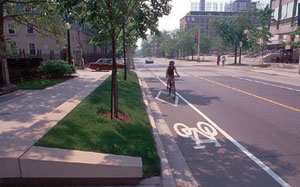 W
WComplete streets is a transportation policy and design approach that requires streets to be planned, designed, operated and maintained to enable safe, convenient and comfortable travel and access for users of all ages and abilities regardless of their mode of transportation. Complete Streets allow for safe travel by those walking, cycling, driving automobiles, riding public transportation, or delivering goods.
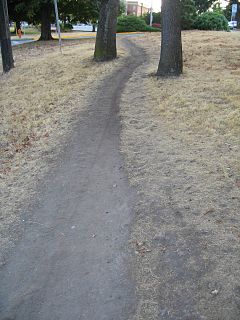 W
WA desire path is a path created as a consequence of erosion caused by human or animal foot traffic. The path usually represents the shortest or most easily navigated route between an origin and destination. The width and severity of erosion are often indicators of the traffic level that a path receives. Desire paths emerge as shortcuts where constructed paths take a circuitous route, have gaps, or are non-existent.
 W
WA greenway is usually a shared-use path along a strip of undeveloped land, in an urban or rural area, set aside for recreational use or environmental protection. Greenways are frequently created out of disused railways, canal towpaths, utility or similar rights of way, or derelict industrial land. Greenways also can also be linear parks, and can serve as wildlife corridors. The path's surface may be paved and often serves multiple users: walkers, runners, bicyclists, skaters and hikers. A characteristic of greenways, as defined by the European Greenways Association, is "ease of passage": that is that they have "either low or zero gradient", so that they can be used by all "types of users, including mobility impaired people".
 W
WA local bike shop or local bicycle shop, sometimes abbreviated LBS, is a small business, as distinct from a chain, mail-order or online vendor, specializing in bicycle sale, maintenance and parts. In the UK and Ireland, the expression independent bicycle dealers (IBDs) is also used.
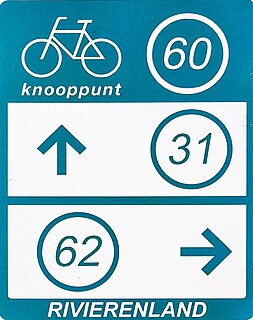 W
WThe numbered-node cycle network is a wayfinding system. It spans the Netherlands, Belgium, parts of Germany, and parts of Croatia, and is expanding rapidly, as of 2017. Each intersection or node is given a number, and the numbers are signposted, so the cyclist always knows which way to go to get to the next node.
 W
WPadstool or fietspadstool is a form of rural wayfinding signage for cyclists, in use in the Netherlands. They are named for their toadstool-like shape; "paddenstoel" first came into use as a nickname around 1921.
 W
WPark and Pedal commuting is a bimodal form of commuting involving a motor vehicle and bicycle. Park and Pedal systems establish parking lots or spaces a comfortable cycling distance from city or employment centers. At the beginning of the workday, commuters leave their cars parked in the lots and pedal their bicycles the rest of the way to work. At the end of their workday, they do the reverse.
 W
WA protected intersection is an at-grade road junction in which cyclists and pedestrians are separated from cars. Vehicles turning right are separated from crossing cyclists and pedestrians by a buffer, providing increased reaction times and visibility. Drivers looking to turn right have better visibility of cyclists and pedestrians as they can look to the side for conflicts instead of over their shoulders. At unsignalized intersections, it is practice to have one car length of space between the cycleway and roadway, so that cars exiting the minor street have an area to pull forward and wait for a gap in traffic, without becoming distracted by potential simultaneous conflicts along the cyclepath.
 W
WA rail trail is the conversion of a disused railway track into a multi-use path, typically for walking, cycling and sometimes horse riding and snowmobiling. The characteristics of abandoned railways—flat, long, frequently running through historical areas—are appealing for various developments. The term sometimes also covers trails running alongside working railways; these are called "rails with trails". Some shared trails are segregated, with the segregation achieved with or without separation. Many rail trails are long-distance trails.
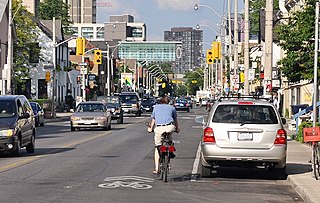 W
WA shared lane marking, shared-lane marking or sharrow is a street marking installed at locations in New Zealand, Australia, Canada, Spain, or the United States. This marking is placed in the travel lane to indicate where people should preferably cycle.
 W
WA shared-use path, mixed-use path or multi-use pathway is a form of infrastructure that supports multiple recreation and transportation opportunities, such as walking, bicycling, inline skating, and wheelchair use. Motorcycles and mopeds are normally prohibited. A shared-use path typically has a surface that is asphalt, concrete or firmly packed crushed aggregate. In the US, the 1999 AASHTO Guide for the Development of Bicycle Facilities defines a shared-use path as being physically separated from motor vehicular traffic with an open space or barrier. Shared-use paths differ from exclusive bikeways in that shared-use paths are designed to include pedestrians even if the primary anticipated users are cyclists.
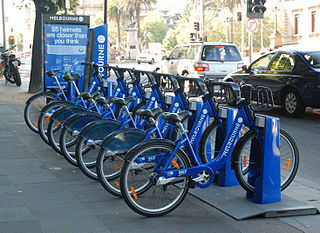 W
WA bicycle-sharing system, public bicycle scheme, or public bike share (PBS) scheme, is a shared transport service in which bicycles are made available for shared use to individuals on a short term basis for a price or free. Many bike share systems allow people to borrow a bike from a "dock" and return it at another dock belonging to the same system. Docks are special bike racks that lock the bike, and only release it by computer control. The user enters payment information, and the computer unlocks a bike. The user returns the bike by placing it in the dock, which locks it in place. Other systems are dockless.